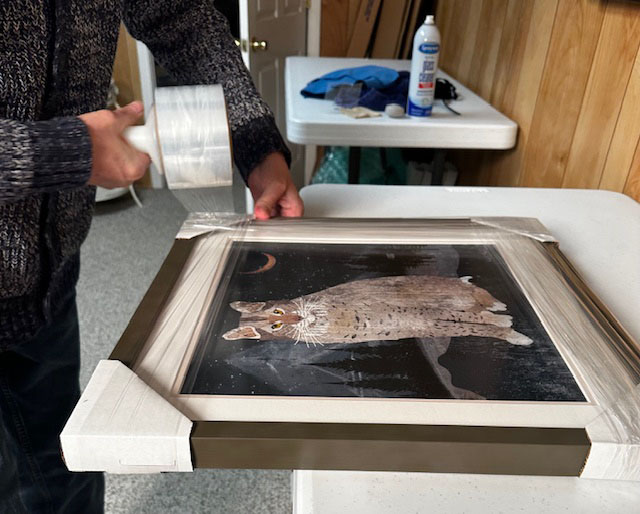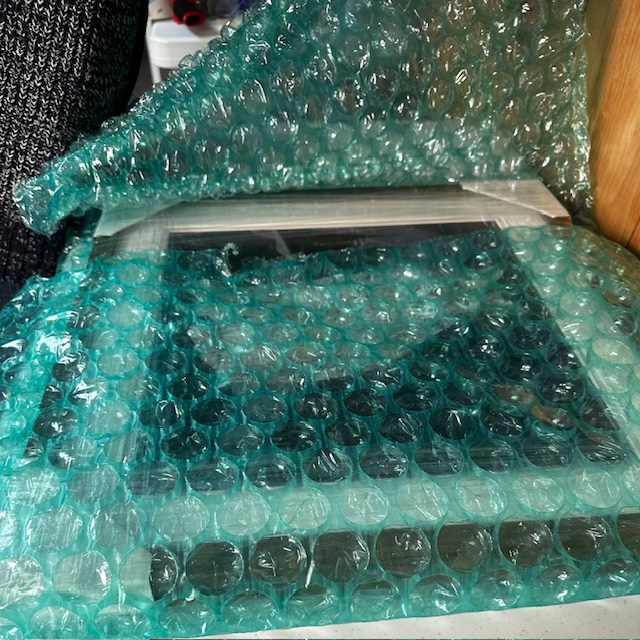Best Practices for Shipping Your Artwork
I recently had my first solo exhibition at the Black Mountain Center for the Arts. The gallery’s policy is that all artwork must remain at the exhibit until after the show closes. One of the customers who purchased a framed artwork from me lives in another state and couldn’t make a return trip to pick up her purchased art. The gallery doesn’t ship artwork and rather than lose a sale, I decided to pack and ship it myself. We’ve worked with FedEx for many years now at Frame Destination because of their positive track record for package handling, I chose them as my shipping company. I listed the steps with shipping it below along with some tips I thought might be useful for artists who are new to shipping their artwork.
Create an Account with Your Shipper
I created a business account with FedEx because it allows me to keep track of my shipments in one place and I can pay my shipping bill monthly. For opening an account, I received a small discount (turned out to be around $6.00 on this shipment). Once you open an account a representative will start calling you immediately. Up to you whether you want to engage; however, if are planning on doing a lot of shipping I would talk to them because you can negotiate better rates if you meet a certain shipping volume. Also, know that if you use a FedEx ShipCenter to pack and ship your artwork the receipt they give you may not be the final charge to your account. FedEx can tack on extra fees later resulting in an unpleasant surprise. Get a rep with whomever you open an account with and make sure you understand their billing practices.
Prepare the Frame for Shipment
You can bring the frame to your shipper as is, but I feel preparing it yourself is a better (and safer) business practice. I photographed Mark, our co-owner, preparing the referenced artwork for shipping using corner protectors from Frame Destination. Corners are typically what gets damaged during transit and our corner protectors act as a cushion for all the bumps and dings that happen on your item’s journey. Mark is securing the corners with stretch wrap, which can be purchased at Uline and other packaging companies. He finished with a layer of bubble wrap (convex side facing the artwork), which can be purchased at numerous places. TIP: if you buy frames from us SAVE your packing materials!


Boxes + Handling Fees
FedEx sells boxes at their authorized ship center locations. If you aren’t shipping more than a few pieces a year this is probably the easiest option because you don’t need to worry about storing the boxes and shipping materials. For my framed artwork plus the corners and bubble, they used the Medium framed art box. You can determine your approximate box size and cost ahead of time by measuring the outside dimension of your framed artwork and adding 2 - 3 inches to each side.
FedEx isn’t the only place to get boxes suitable for shipping artwork. Uline is the premier packaging company and they offer a wide variety of boxes including ones suitable for art. They do have to be purchased in quantity and shipped. U-Haul is another option. They have a mirror and picture moving box, and you can order and pick up boxes from them at your local U-Haul facility. It’s a rather large box, but it’s possible you could cut it down to fit your artwork.
FedEx, at least the one in Asheville, NC, charges a $10 handling fee for putting the art in a box, and they don’t add corner protectors. You can bypass this fee, and have more security about shipping your art, by buying the box in advance and preparing/boxing it yourself. When preparing it for shipment remember to pay attention to the corners, use protectors if you can, and make sure the wrapped frame is centered inside of the box with at least one inch, preferably 2-3 inches depending on the frame size, between all sides of the frame and the box. Add some additional packing material on all four sides such as crumpled paper. Also, acrylic glazing is always a safer choice when shipping than glass. Keep this in mind when you are framing your artwork if you think there is a possibility of shipping it to a customer.

Dimensional Weight Shipping Fees
I hate paying shipping as much as you do; however, after being in this business since 2004, I understand it. Shipping charges are based on dimensional weight, also known as volumetric weight, which is a pricing technique for commercial freight transport using an estimated weight that is calculated from the length, width, and height of a package. This means a large framed artwork that might only weigh a few pounds can cost a lot. Basically, they are charging you for how much space your artwork takes up in their truck or airplane. One of the best ways to control your dimensional weight is by packing your artwork in a box that’s closest to the size of your artwork while still providing adequate protection.
In summary, shipping artwork, just like framing it, is a whole other ballgame beyond creating the art. We at Frame Destination are here to help! Please feel free reach out to us at 972-479-1188 or info@framedestination.com.
Learn more about an additional option to keep your art protected with Clear Bags.
Last Updated December 21, 2023
Written by Joely Rogers
 Joely C. Rogers is an artist/illustrator and writer living in the mountains of western North Carolina. She has professional training in both natural science illustration and the culinary arts, as well as graduate academic training in education, sociolinguistics, and folklore/storytelling. She is a Blue Ridge Naturalist candidate with the North Carolina Arboretum and a member of the Guild of Natural Science Illustrators.
Joely C. Rogers is an artist/illustrator and writer living in the mountains of western North Carolina. She has professional training in both natural science illustration and the culinary arts, as well as graduate academic training in education, sociolinguistics, and folklore/storytelling. She is a Blue Ridge Naturalist candidate with the North Carolina Arboretum and a member of the Guild of Natural Science Illustrators.